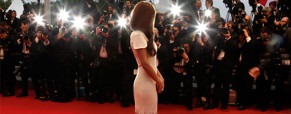Lights, Camera, Fashion, PR
Posted: September 26, 2014, 7:45 p.m.
by Katie Foster Howard.
Cameras flash, fans squeal and photographers demand more angles, more poses. In the middle of this red carpet frenzy, a celebrity has one very important question to answer: “Who are you wearing?”
The red carpet interview is a PR strategy for both fashion PR and celebrity publicists. Fashion designers want their best looks to be worn by the most successful and beautiful celebrities, and celebrities need that perfect red carpet look. The red carpet has turned into a runway for the most celebrated and innovative designers, but it hasn’t always been this way.
In 1922, Sid Grauman rolled out the first Hollywood red carpet at the opening of his Egyptian Theatre as a means for fans to connect with starlets beyond the screen.
“Without paparazzi, tabloids or the Internet (and the lowbrow wannabes this holy trinity brings) the red carpet was an exclusive, far-away place where the world’s most charismatic movie stars were seen,” Julie Miller said in her Vanity Fair piece, “The History of the Red Carpet.”
According to Miller, the catalyst that transformed the red carpet to a runway was the sequined pantsuit that Barbra Streisand wore to accept her Oscar for Funny Girl in 1969. This particular fashion choice inspired a sort of red carpet fashion renaissance where stars started dressing themselves based on their varied fashion senses.
“Actors [were] more in control of their wardrobes,” Bridget Foley, editor of Women’s Wear Daily, explained to Miller. “Ironically, the result was more diversity because what celebrities wore more accurately reflected their personalities and senses of style than we see today.”
With the creation of People magazine in 1974, the Joan Rivers red carpet interview in the 90s and today’s social media, everyone is able to analyze celebrities’ fashion choices.
“When a celebrity is spotted wearing a designer gown (or tux) on the red carpet, it provides a wealth of future PR opportunities, as well as that initial ‘What are you wearing’ brand drop,” said Crosby Noricks, a fashion brand strategist and founder of PR Couture. “Celebrity weeklies will immediately cover who wore what, and ending up on the best dressed list is pure PR gold.”
Publicists are responsible for putting their clients in the best light, but how do you do that with cameras flashing at every angle?
Enter the stylist. Fashion designers as red carpet stylists give stars fashion credibility, while also gaining free publicity from the exposure on the red carpet. This seems like an almost perfect relationship between fashion and entertainment public relations. However, there is one important factor both of these entities seem to be forgetting: their audience.
Some viewers argue that the red carpet’s focus on fashion is demeaning to those walking it — especially women. One of these viewers is Jennifer Siebel Newsom, the founder and CEO of The Representation Project, which is “a call-to-action campaign and media organization established to shift people’s consciousness, inspire individual and community action, and ultimately, transform culture.”
“As a filmmaker and former actress, and someone who has had the fortune of attending red carpet events in the past, I know the feeling of being a piece of meat on display for the media – the way they yell out for your attention, then seemingly discard you after snapping a photo or looking you up and down,” said Newsom in an article on The Daily Beast. “It can be traumatic, and something incredibly difficult to stand up to.”
The Representation Project stood up to this red carpet treatment by creating the #AskHerMore Twitter campaign for this year’s Emmys. The hashtag aimed to highlight an actress’ achievements, rather than her fashion choices, on the red carpet.
Over 6 million people engaged in the #AskHerMore Twitter conversation, signaling that people want more from starlets than their favorite brands and beauty regimens.
“We hope to continue #AskHerMore for future red carpet events, to implore red carpet reporters to go beyond physical appearance, and ask more substantive questions than just the ones about fashion,” said Newsom in an interview with Platform. “Hopefully this will lead to treating actors, of both genders, as agents rather than objects.”
Modern public relations urges two-way communication between a brand and its publics, and the #AskHerMore campaign definitely started a dialogue between celebrities and their fans. Yet, Adrianna Lauricella, co-founder of nyc PR girls, urges that the appreciation of red carpet fashion is important to certain publics as well.
“The shift in the interest of fashion only shows its importance and relevance in today’s culture,” Lauricella said. “While we’re interested in what the celebrities have to say about their nominations, what they are wearing is always the most eye-catching and sparks the most commentary.”





